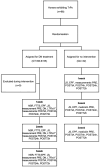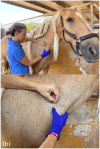Clinical Effectiveness of Dry Needling on Myofascial Trigger Points in Horses: A Prospective Algometric Controlled Study
- PMID: 40804997
- PMCID: PMC12345582
- DOI: 10.3390/ani15152207
Clinical Effectiveness of Dry Needling on Myofascial Trigger Points in Horses: A Prospective Algometric Controlled Study
Abstract
Myofascial pain syndrome (MPS) is caused by trigger points (TrPs): hypersensitive spots in taut muscle bands that impair function and cause pain. Dry needling (DN) is a common treatment in humans, but evidence in horses is limited. This prospective, controlled study evaluated the effectiveness of DN in reducing TrP-related pain in the brachiocephalic muscle of horses. Of the 98 horses enrolled, 66 were allocated to a treatment group receiving weekly DN sessions for three weeks, while 32 were assigned to a control group with no intervention. Pain and function were assessed using pressure algometry, a numerical rating scale (NRS), a functional total test score (FTTS), and behavioral indicators including jump sign (JS), equine pain face (EPF), and local twitch responses (LTRs). Assessments were performed at baseline and at 0, 4, 24, and 72 h post-intervention. Results indicate a significant increase in pressure pain thresholds (p < 0.001), especially after the second and third sessions. Both NRS and FTTS improved significantly over time (p < 0.001), and LTRs progressively decreased. EPF and JS showed minimal variation. These results support the use of DN to reduce local muscle pain and improve function in horses with TrPs. Further robust studies are warranted to refine protocols and investigate long-term effects.
Keywords: algometry; dry needling; equine brachiocephalic muscle; horse; myofascial pain syndrome; pain; palpation; trigger point.
Conflict of interest statement
The authors declare no conflicts of interest.
Figures










Similar articles
-
Effectiveness of dry needling for upper-quarter myofascial pain: a systematic review and meta-analysis.J Orthop Sports Phys Ther. 2013 Sep;43(9):620-34. doi: 10.2519/jospt.2013.4668. J Orthop Sports Phys Ther. 2013. PMID: 23756457
-
Prescription of Controlled Substances: Benefits and Risks.2025 Jul 6. In: StatPearls [Internet]. Treasure Island (FL): StatPearls Publishing; 2025 Jan–. 2025 Jul 6. In: StatPearls [Internet]. Treasure Island (FL): StatPearls Publishing; 2025 Jan–. PMID: 30726003 Free Books & Documents.
-
Botulinum toxin for myofascial pain syndromes in adults.Cochrane Database Syst Rev. 2014 Jul 25;2014(7):CD007533. doi: 10.1002/14651858.CD007533.pub3. Cochrane Database Syst Rev. 2014. PMID: 25062018 Free PMC article.
-
The effects of dry needling on muscle blood flow of the infraspinatus muscle in individuals with shoulder pain - a randomized clinical trial.J Man Manip Ther. 2025 Aug;33(4):299-308. doi: 10.1080/10669817.2025.2464542. Epub 2025 Feb 10. J Man Manip Ther. 2025. PMID: 39930809 Clinical Trial.
-
Acupuncture and dry needling in the management of myofascial trigger point pain: a systematic review and meta-analysis of randomised controlled trials.Eur J Pain. 2009 Jan;13(1):3-10. doi: 10.1016/j.ejpain.2008.02.006. Epub 2008 Apr 18. Eur J Pain. 2009. PMID: 18395479
References
-
- Dommerholt J., Bron C., Franssen J. Myofascial trigger points: An evidence-informed review. J. Man. Manip. Ther. 2006;14:203–221. doi: 10.1179/106698106790819991. - DOI
-
- Simons D.G. Revisión de los enigmáticos puntos gatillo miofasciales como causa habitual de dolor y disfunción musculoesqueléticos enigmáticos. Fisioterapia. 2005;27:103–120. doi: 10.1016/S0211-5638(05)73423-4. - DOI
-
- Solís J.C. Síndrome de dolor miofascial, diagnóstico y tratamiento. Rev. Med. Costa Rica Cent. Am. 2014;71:683–689.
-
- Simons D.G. Diagnostic criteria of myofascial pain caused by trigger points. J. Musculoskelet. Pain. 1999;7:111–120. doi: 10.1300/J094v07n01_11. - DOI
LinkOut - more resources
Full Text Sources

